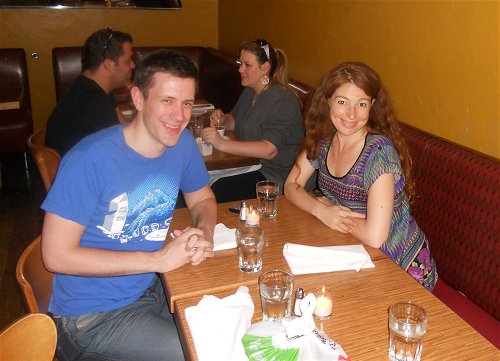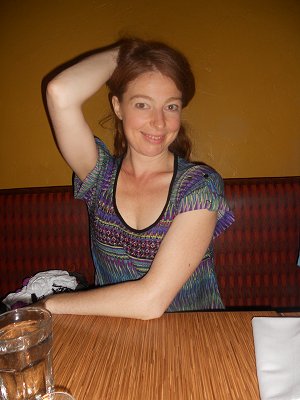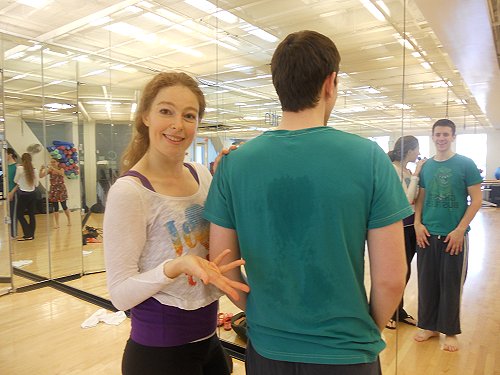NEW YORK CITY
July 16, 2011
STRANGER: Julia Kulakova
LOCATION: Josie’s West, 300 Amsterdam Avenue, New York City
THEME: Dinner with a dancer
My dance moves are as graceful as Mr. Bean’s efforts.
That’s a line I often use at nightclubs to explain my reluctance to dance. It’s also a line I use to prolong that image of the charming, daffy Brit abroad, though having blown my cover with this confessional I’m going to have to come up with a new quip.
I might have uttered the line for the last time as I took part in an hour-long Gypsy dance class in New York led by Russian dancer — and dining stranger — Julia Kulakova.

Yes, Julia can now count herself as one of the questionably lucky handful of people who have witnessed me trying to pull shapes to a beat. She got in touch with me after reading my interview with Cuban singing sensation Margarita Pracatan. Turns out Margarita sometimes takes part in Julia’s regular dance class, and told her about sitting down to dinner with me a couple of years ago.
Julia and I agreed on having a late lunch in Manhattan. But before that we had to work up an appetite, and that meant it was time to put on my dancing shoes.
Or more accurately take them off. Julia’s class, held at the Jewish Community Center on Amsterdam Avenue, is barefoot. I threw on a Ghostbusters t-shirt and sweats (admittedly my winter bedtime clothing, but let’s pretend I didn’t say that), kicked off my sneakers and got ready to impress the entirely female class of regulars with my limited dancing ability.
My good friend Mariola accompanied me so that I could get pictures during the class without interrupting the lesson. Instead, Mariola took several videos of my attempt. If you just came here to laugh at me, skip to the bottom of the article where I talk more in-depth about the class and helpfully provide a cringe-inducing video showing me attempting to bust a move.
If you’re also here for the interview, then bless your heart. Reading about Julia’s life and her ethos when it comes to teaching others to dance will be a better introduction to her class than me jiggling like a jester.

Following our dance workout we went for lunch at the nearby Josie’s West (the restaurant has another location across town called Josie’s East). We grabbed a table for four: myself, Julia, Mariola and Julia’s friend Apurva, who was taking photos of the dance class.
After putting in our orders, Julia told me her condensed life story, speaking in a soft yet confident voice with a generous twang of Russia still evident.
Julia is from a small place called Ryazan in Russia. Moscow is the closest big city, and it’s where she went to dance school. “I danced all my life. I wasn’t taught in school. That’s what gives me the right to actually teach because I feel the need for it and it’s not like I was at school and someone taught me how to dance. I always wanted to dance,” she said.
Growing up dancing whenever she felt like it and watching Bollywood movies with their elaborate dance routines, Julia had a firm sense of identity by the time she enrolled at school. “By the time I got into that musical theater school my mind was very clear that I’m a dancer, and my parents were very clear that I’m a dancer, and my friends were very clear that I’m a dancer.”
She had a steady curriculum of ballet, jazz, modern and folk dances which dancers need to posses to be able to jump into doing choreography for a wide range of shows.
After school she moved to New York City in 1997 on a contract, choosing the Big Apple over other places including San Francisco and Albania. In America she started with Vegas-style showgirls routines at clubs on New York’s Brighton Beach. Over time she’s built up quite the career, including belly dancing appearances at the Turkish restaurant Turkuaz and her weekly Gypsy dance workout class at the Jewish Community Center.
What is Gypsy dancing?

It comes from the Gypsy culture, but specifically Gypsy culture that originates in India. “Gypsies have been doing this for centuries and centuries and they have been performing for the audiences in order to get money in order to get their living,” Julia said.
She compared Gypsies to street or subway performers in New York who dance or otherwise act out for cash. “They have to wow the audience, stop them in their tracks and to impress them to that point that they part with their hard-earned money.” Gypsy dance is therefore very commercial so that it can sell right away, Julia said. Also important is the added instant audience feedback.
“It’s a drastic difference between contemporary artists because contemporary artists went to the studio and they threw out their souls and their troubles and hard childhood or something into the song and they play the song to people, to producers, to their friends, and nobody likes it and the artist thinks well they just don’t get me, they just don’t know anything about the art, they are just not qualified to be judges. On one hand they’re right but on the other hand Gypsies actually faced this problem a long time ago and they were not having this attitude,” Julia said.
Gypsies instead learned to adapt instantly whenever their dances weren’t winning the favor of the paying audiences. “They were having the attitude that I kind of see that you may be a little bit bored so let me do something more interesting. So that’s one of the specifics, it’s constant connection with the audience and constant analysis of the feedback,” she added.
One thing Julia tries to teach in her class is to play music with one’s body, so that pupils start by clapping a beat, then clapping that beat on their shoulders before the shoulders start moving to the beat themselves. She contrasted it to Western modern dance choreography which doesn’t always necessarily move to every beat of the music.

If that’s the case, what makes a truly great dancer? “The best dancer is the person who is together with the music so we always know, we look at the person and we know he’s a dancer, he’s not a dancer, simply because it’s either the match of the music or no, and the match of the music is like on the beats and then with the sense of it,” Julia said.
Trying to show people the joys of dancing is an ongoing quest for Julia through her workouts. “When I moved to the United States it surprised me how, in general, I met people who are not accustomed to dance.” But she said anyone can become a great dancer if they keep practicing at it and just learn to enjoy the music and the movements, something she stresses in her classes. She’s been teaching dance for five years and Gypsy dancing in particular since 2008.
She takes a different approach with different students which prevents the classes from becoming super-standardized. Julia has a lot of repeat pupils each week, and is pleased whenever she sees progress. For example, there’s the woman who came into her first class proclaiming, “I’m not a dancer” but just one year later she’s got the moves down to a fine art. “I am very thrilled that now, just a year later, she’s such an eye candy in class,” Julia said with a smile.
As our waiter brought out our food there was a moment of silence that allowed to me reflect on how whip-smart Julia is. She paid attention to every word Mariola and I said and quickly picked up on our comments and characteristics. Julia also had long, detailed and intelligent answers for all of our questions, making it one of the interviews where my brain had to work in overtime just to keep up with her.
Part of the reason might be that Julia is a rather analytical person, something that stems from her teaching. “I keep analyzing what happens in the class. I kind of know how to get this person to do this move or to open up.” It’s a vastly different approach from her dance teachers in Moscow who showed the door to anyone who couldn’t instantly learn a dance move, she said.
After taking her class I can confirm I’m definitely in the group of people who can’t instantly learn dance moves, though Julia was a patient teacher. But I had more important things on my mind as my piping-hot lunch was now sitting in front of me.

I opted for organic angel hair pasta with freshly ground turkey meatballs, served with organic roasted plum tomatoes, garlic, basil and olive oil. The pasta was perfectly cooked and lightly salted, but the turkey meatballs were a little bit of a letdown. They were plenty filling but rather bland, the consistency of chewing plasticine with an indistinguishable, middling flavor.

My friend Mariola had better luck with a warm macadamia-crusted chicken breast salad of organic mesclun greens, mango, cherry tomatoes, avocado, organic orzo and balsamic vinaigrette. For once I can vouch for another person’s dish because I stole some of her leftovers later that day. The chicken and the macadamia crust was outstanding, the salad good even after a few hours.

Apurva and Julia split two dishes. First was an all-vegetarian meatloaf made of organic lentil, seitan, shiitake mushroom and sweet potato, served with a miso gravy and wok-sautéed greens. It must have tasted good because at one point Julia asked me to stop asking questions and instead talk about myself so she could savor the food.

They also split an order of jumbo lump crabcakes served with organic mesclun greens and a lemon-basil aioli. Similarly while I didn’t try that dish, I have to assume they both thought it was delicious as there was little left on the plate at the end of our lunch.
As we ate, Julia said that the desserts at Josie’s are delicious but suggested leaving room for dessert later that night at Turkuaz, which she said offers interesting puddings. Alas her show didn’t happen that night so we never made it to the restaurant. Maybe another time. She’s been working there for six years so I should be able to catch her dancing performance eventually.
The job at the restaurant came about following a performance Julia did in an off-Broadway show based on James Bond movies. She played a Bond girl and choreographed a belly dance. The reception was great and people suggested she make money off it by performing at Turkuaz. “I was thinking, well this is a paid gig so why not?” and a lengthy relationship with the place began.
Julia’s dancing work has also taken her overseas, including Italy, Russia and a United Nations Educational, Scientific and Cultural Organization conference in Spain two years ago where she did workshops and presentations on the culture of Gypsy dance while also performing on an outdoor stage. “Dance is almost better than a photograph, it preserves the culture” Julia said.
Speaking of culture, Julia has a theory on that. “I have noticed that the most intellectual people are the worst dancers,” she said. I was going to take that as a compliment given my awkward dance floor movements but then I remembered that I have a pea-sized brain.

Nevertheless Julia thinks there’s a difference between the rote method of learning and real-life learning that can be crucial to dancing. “I think that in contemporary education the focus is not on intellect but on accumulation of encyclopaedic knowledge versus the way of living, the way of being a person, the way of being the best person, and as a result the contemporary educational system produces a lot of people who are very good at solving crossword puzzles but that’s a very broad selection of facts and when it comes to living your life, it doesn’t really help.”
As a result, Julia said the eggheads of the world don’t have a core skill of training the connection between the mind and the body that can be crucial for dancing. “I think that when we switch more towards hardcore factual education we are losing some physical sensations,” she said. “Everybody becomes less and less thrilled about running in the park or swimming or just enjoying different states, and dancing is also a different physical state, but it’s so much easier to open the book and disappear in the book.”
The classes, dance nights at Turkuaz, choreography and other dance work elsewhere in New York City keeps Julia busy. “If I’m not teaching, if I’m not choreographing, if I’m not thinking about costuming my new dance or even existing performance, if I’m not describing something for my workshops, I just keep thinking about the classes and what happened and what worked and what did I hear from people, what was the feedback?” she said.
So how was Julia’s dance class?

Difficult. For a chump like myself to try and learn dance moves is a daunting task. I hate to use the word “bubbly” to describe anyone, because I feel like words like that belong in a Barbara Cartland novel or at a polo game back in England. But Julia really is a bubbly personality. I believe she was smiling throughout the class and her patience with her awkward British student knew no limits.
Julia started with exercises to get her students to loosen up their bodies, stretching limbs and reminding me that I really need to pay more visits to that strange place called the gym.
Then she started the vibrant Gypsy music (along with a few more conventional upbeat tunes) and we were off. Clapping, stomping, shaking our bodies side-to-side and doing some kind of pelvic thrust that all the women had down to a tee but that when I did it looked borderline obscene.
Throughout the class Julia offered encouragement to each and every student, along with some hands-on guidance at times. She seemed determined to ensure that everyone was having a good time, even if some of us — all right, just me — weren’t great at pulling off any of the moves.
Plus everyone that came out the class seemed to be smiling. “If you noticed, people who were waiting before the class and people who came out of the class, there were completely different facial expressions. That’s because we played different beats on our body and we changed our own physical frequencies,” Julia said, echoing her earlier remarks about letting the body play the music.
Lest you think I’m being a Debbie Downer about my dancing skills, or that I’m being bashful when I actually move like Johnny Castle, allow me to wrap up this interview by providing the aforementioned video of my efforts that day. You were warned.
plpzv5